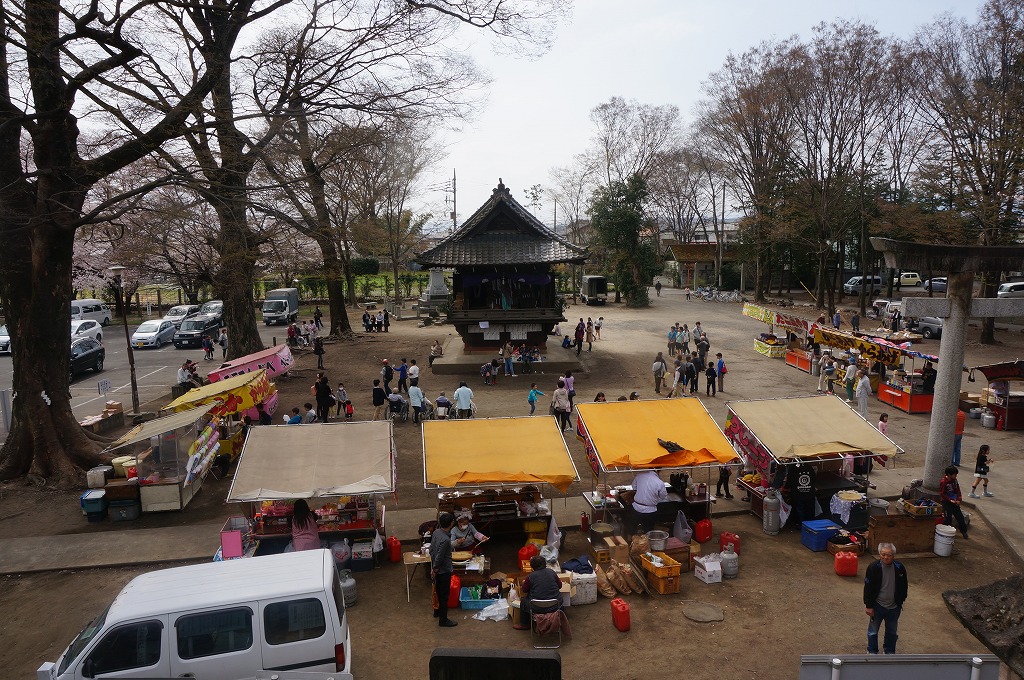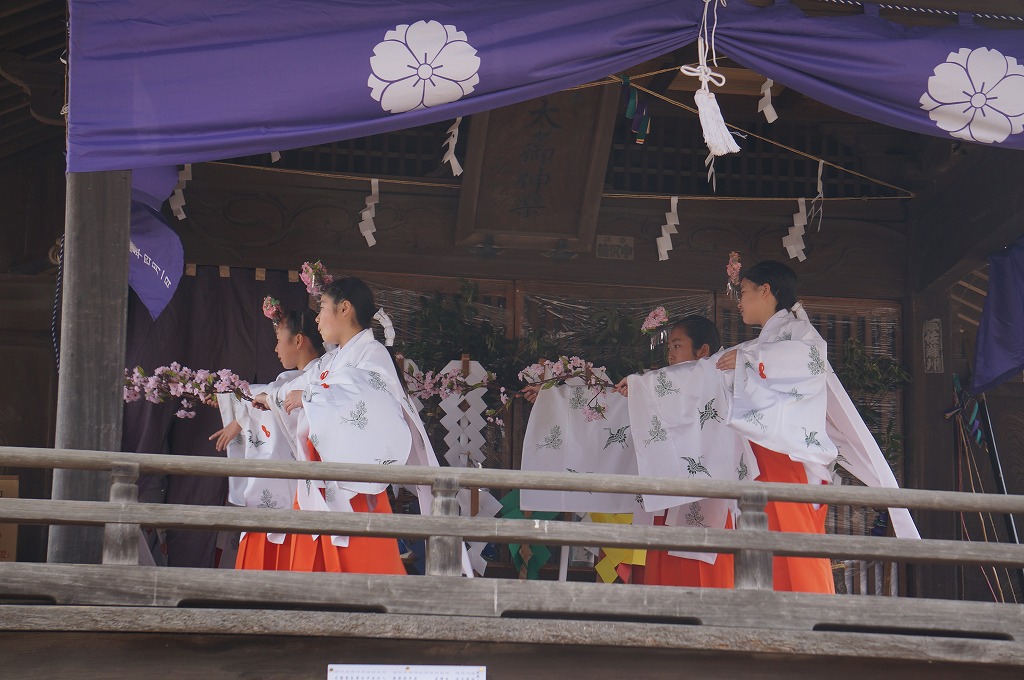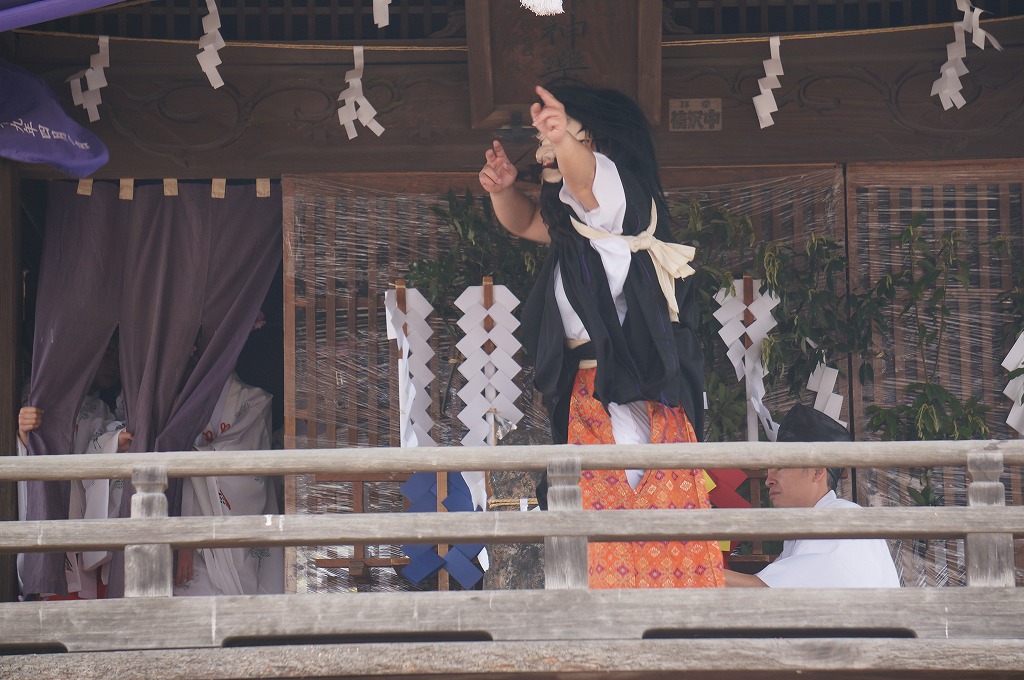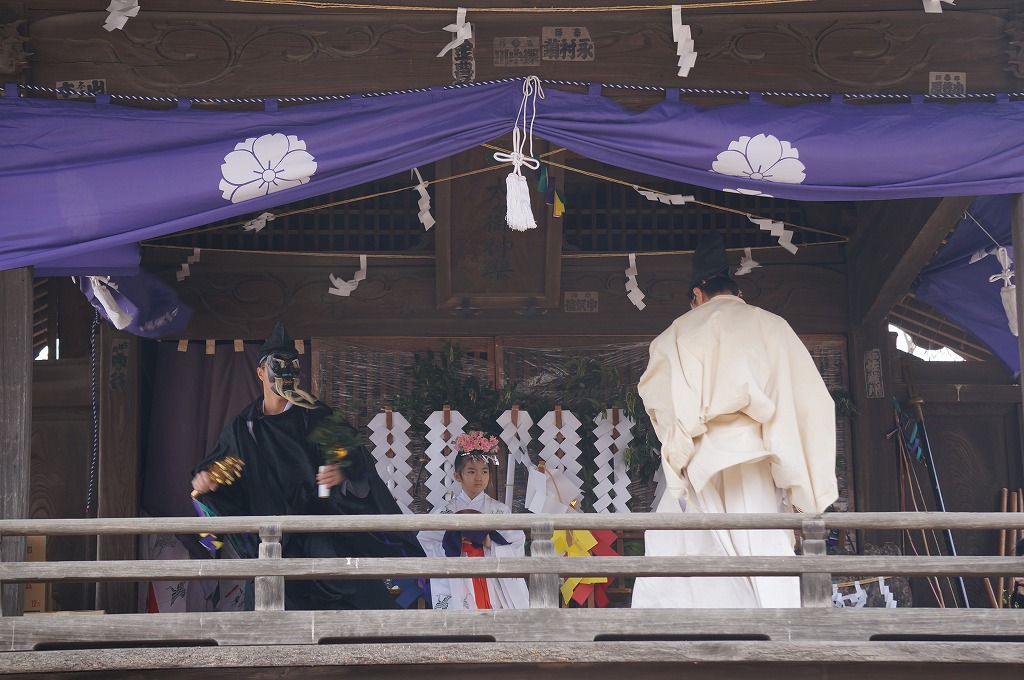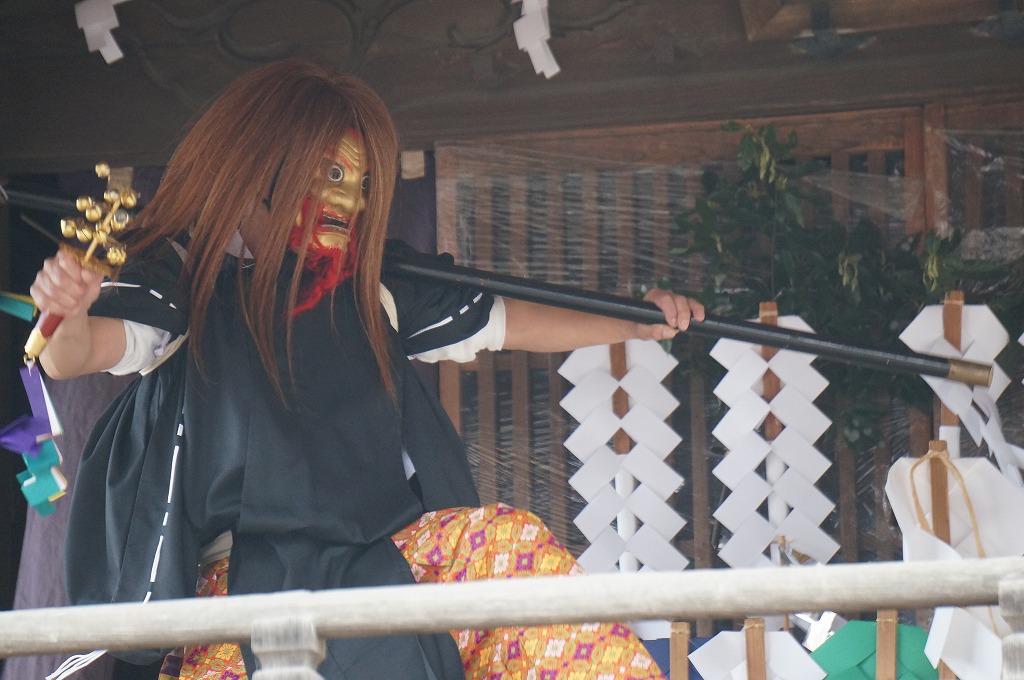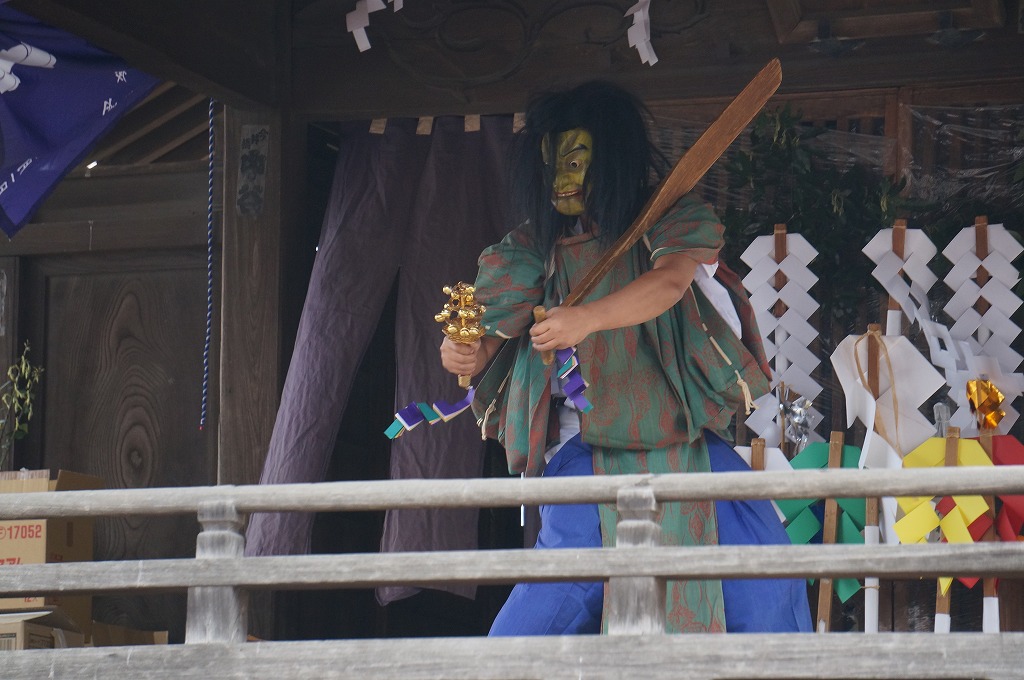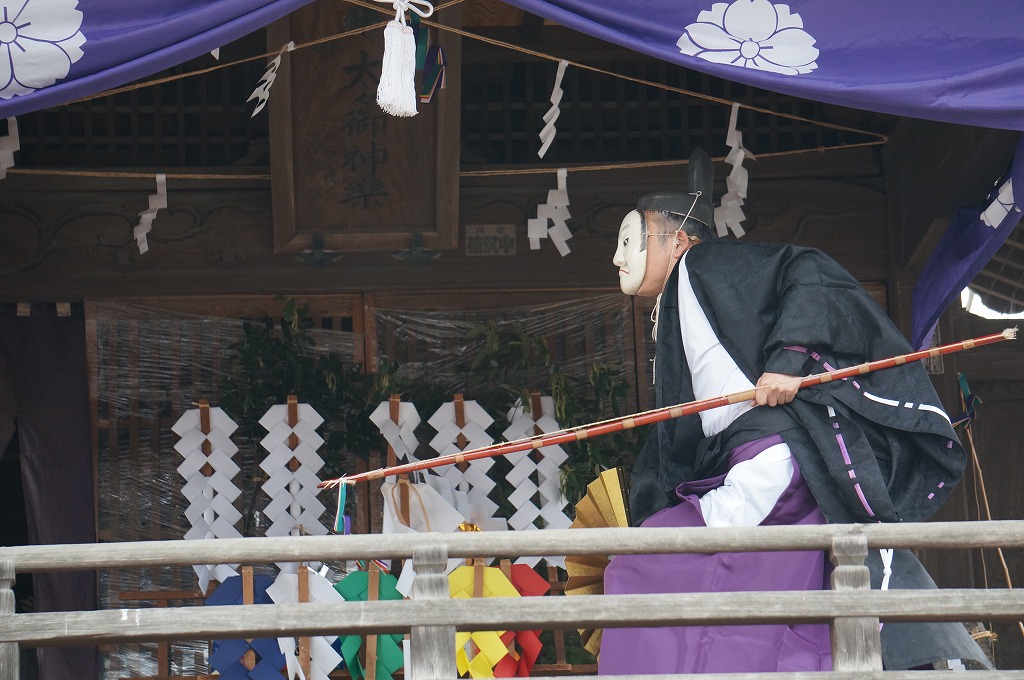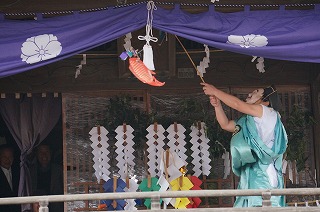Report: Would you mind spending a calm day at a place away from urban noise? Part 2~Iidama shrine Daidai kagura~
Date; 1st Sunday April, every year
Location; Hirose town 2-2-8, Maebashi city, Gunma prefecture
Access; It takes 20 minutes from Naebashi station (JR) on foot
Mebashi is 1 and half hours from Tokyo
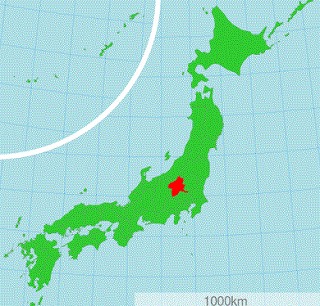
Introduction

This time, we will introduce “Iidama shrine Daidai kagura”.
This Kagura event is held at the Iidama shrine every spring. “Daidai” is a word usually used in the event in the Kanto area and means “bigger and bigger”. Tears ago, kagura was sometimes held for people to get their wishes. The stronger the people’s wish was, the bigger the scale of the kagura became, because they paid a lot of money. So, the name of the kagura became “Dai kagura” from merely “kagura”. Dai means big. Finally, it is said to have come to be called “Daidai” kagura, according to some views.
This period (from end of March to the begining of April, about two weeks) is one of the best season in Japan. Many cherry blossoms bloom all at once and Japan is covered with the color of pale pink. So, if you go to this event, you would see beautiful scenery all over this area.

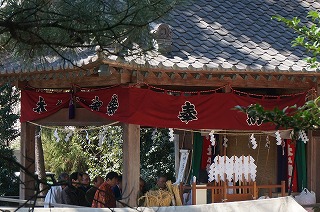
This kagura is performed at lunchtime from about 11 am to 3 or 4 pm every year.
*This article was written from the writer’s experience visiting in 2017.

This time once again two men (Modoki and Sarutahiko) seem to be ready to guide you.
Here we are. This is Iidama shrine.
This shrine is in the middle of a residential district, isn’t it?
Yes. Well, what time is it now?
It’s about 11 am, just on time for staring. But the kagura event does not start yet, does it?
Such things happen. I would use this spare time effectively to introduce the feautures of this kagura. This is the kagura typical in Kanto area. The first half is very ritual and the second half becomes comical.
Do people like me get on the stage?
Yes,. Performing only a refined and sophisticated program would make the audience bored.
20 minutes later.
The first program seems to be starting.
First half~ritual part
At first, two deities come in. “Sarutahiko“

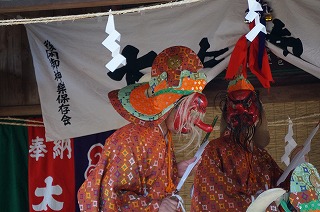

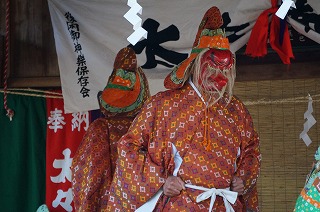
Are they Sarutahiko?
Yes, we often get on the stage at first because we are guides for all deities.*→Reference/Japan mythology, please
This is a rare program. Two men are playing.
Right. It’s rare in Kanto area. But four men get on the stage in Okayama area.
Really? In addition, one mask has black beard and mustache and the other has white ones. And they have long eyebrows! They look like whiskers.
THey are my colleagues. Don’t quibble about deities’ face. This is the refined program.
Next program “Four sieties“. Four men without mask are dancing slowly.


I guess that the moves of this dance are simple but skilled.
You come to understand kagura at last.
Thank you.
But stay focused and study even harder.
Oh, are you giving me a lecture again?
Next “Uzume or Okame”. One dancer is holding Gohei (staff with plaited paper streamers in Shinto) and a bell comes on stage. THe feature of this dance is a slipping like movement.


Uzume looks like she’s having fun.
The face of the mask has small eyes, long -slit and narrow eyes, and slender face with large jowls. This is for Okame.
It means funny face?
Although it may vary according to the time, this face is characterized by stylized beautiful woman figures.
Different times, different minds.
Intermission from 12:20 pm to 1:00 pm.
Next program, “Tajikarao“. He has a staff like a shield.


Have you heard his name?
Of course. I am a humble member of kagura. When Amaterasu had hidden behind Amano-Iwato (a door by rock), he took it off.
Yes. He is the most powerful deity.


He has long eyebrows, too. And what is that? Long hair like a beard grows from under the eyes. It is an eyebrow or beard?
Shut up and look at his action. It seems to raise the wind!
Sure. It is getting a little cold from the wind.
He is coursing the wind by his power.
No way!
Next program; “Ameno Koyane“. One person wearing white old man mask comes on the stage. He is holding a bell and a white fan.
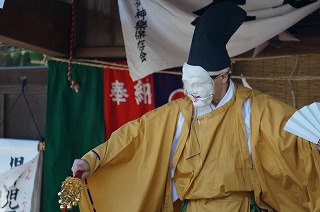

Have you heard his name?
No.
He is a clever deity. At an affair of “Iwato-biraki”(Amaterasu behind the rock door. →Reference/Japan mythology), he took measures with Omoikane (a deity of the cleverest). And he is the founder of the Fujiwara clan. The Fujiwara clan has reigned this country for 1,000 years as the aide of emperor.
He looks gentle and elegant. He doesn’t like he has political power. A man can’t be judged by his appearance. Shoot! not man, yes deity.
Second half~comedy part
At 1:30 pm. “Tanemaki”. It means sowing seeds. A fox appeared following an woman holding rice plant.


Is she a deity of agriculture? I considered a deity of agriculture an old man. It is rare case.
Probably I guess she is a messenger of Inari.

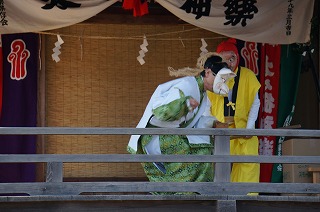
A fox is jumping crouching position. This is a popular image of a fox in kagura. A woman gave some rice plant and has left. Following, two men appear. They both wear a yellow cloth and one man wears a red towel on his head.
Hey, omg! Finally our colleague comes on the stage.
I’m sure that he might cause an incident,too.



Unexpectedly, he is competent. After being taught how to plant form the fox, he started working easily and joyfully. When he is planting seeds just like dancing, another man comes in. He wears a yellow cloth and yellow towel on his head. He is bringing a big basket. After he puts the basket down, a man with red towel begind to teach him how to plant the seeds.


Oh, I see. They are vaudeville actors. The man with the red towel is a straight man and the man with the yellow towel is the comical character.
Aren’t they the same role?
Yes, but they are two of a kind.
So, teach me what they are talking.
Yes, it’s easy.
*Following the conversation is Modok’s fictional transration.
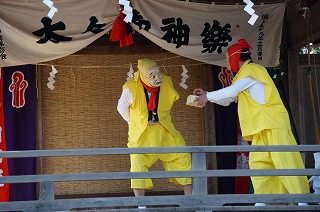
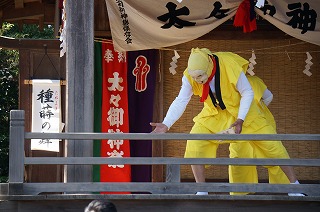
Do as I do. At first you hold this tool, you break up the ground.
Why?
I don’t know. After you break up, throw these beans as I do.
What these?
I don’t know either.


While they were doing this, one woman appears. She wears a cooking coat. She is called “Okame” or “Otafuku”. She begins to take care this and that.
These are seeds. If you throw on the ground, these will grow up into rice.


Following Okame, an old man appears.
He is not just an old, he is a great deity, “Inari”.
Really? Thankful and fortune for humans like us.
Nevertheless, the Inari did almost nothing. He just smoked a long pipe while looking over spring scenes.
Why does Inari do nothing?
He is a deity. A deity will be a such a being. Anyways, what are they doing?


Ah, they have tied their each hands though they wanted to tie straws. This is a typical comedy style.
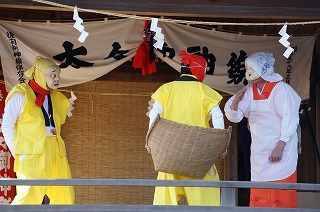

Inari doesn’t get fazed by anything. That’s a deity.
He looks only lazy to me.
After all, Inari and Okame left. Two of Modokis begin putting rice into a big straw bag.
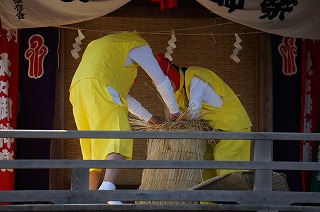
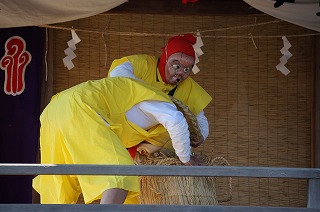
Ouch! Stop. You are putting my head into bag together with rice.
I’m sorry. I got to absorb in doing this.
Really?


And now, keep doing it. I’ll keep open the bag.
OK, I’ll try.
Ouch!…
What are they doing?
This is Modoki. (laughing)
Two Modokis managed to finish. Next, they have to bring it.
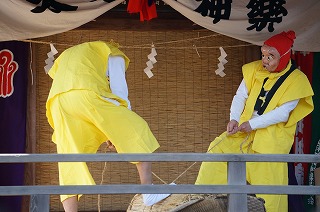
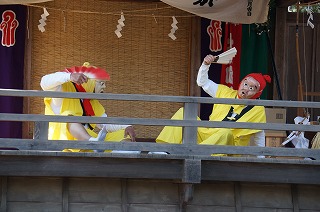
Well, sit down there. I’ll help you carry the bag.
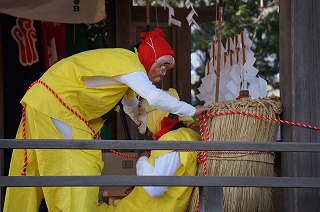
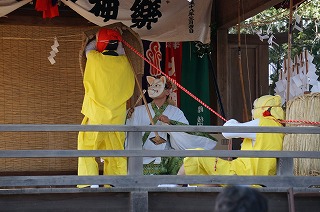
Red finished tying. Yellow wants to stand but cannot. Red helps him to carry the rope.
Then, fox comes out again.
It’s too heavy. It wouldn’t budge.


WHat are you doing? You are tying the rope to the pillar.
No wonder it’s heavy.
Pull yourself together. Cheer up!
Aren’t they hasty and careless?
That’s Modoki.
They are left finally with the fox. This program takes over 30 minutes.
Next program “Daikoku’s mallet”.
Daikoku is a deity of fortune. He always has a little mallet. The little mallet is a famous staff which people imagine as soon as people hear the name “Daikoku”. Daikoku swings the mallet, then a lot of treasures appear immediately.
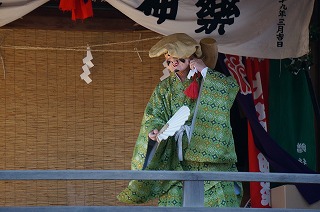

People have gathered again, haven’t they?
Most people know when Ebisu or Daikoku appears, happy time is coming.


The Modoki with his head covered by a red towel comes out again. I don’t think this program is going to end well.
Really?


Look at the stage. Daikoku gives modoki something.
He seems at a loss. Ah, he has given the staff to the audience.

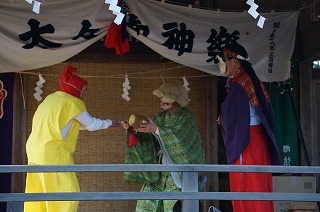
Daikoku gave a bell, mirror, and the mallet at last and he has left the stage.

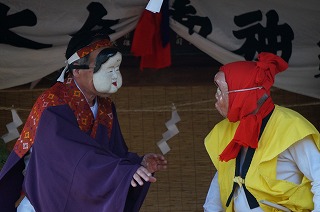
Okame comes out and teaches how to use the mallet to modoki.


Daikoku swings the mallet to bring out some treasures but….What does his swinging the mallet make appear? I still doubt whether this program is going to end well.


Modoki swung the mallet and a strange being has appeared. It wears an all-pink clothes and has a pink face.


What is that?
I don’t know. I guess he or she is a monkey from the face.


Anyway, modoki ties the monkey-like creature to a pillar. Modoki starts dancing in front of the monkey-like creature but it has vanished without noticing.

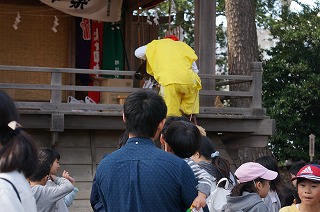
What happens? The monkey-like creature has come to the audience.
He is greeting the audience. Modoki is upset and brings the monkey-like creature back to the stage.


After all, what does red modoki try?
I guess he will try to teach dancing.
Modoki holds a rope, and the monkey-like creature is dancing. He is like a monkey trainer.
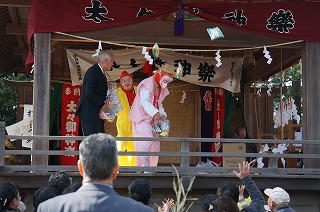
Suddenly the mochinage ceremony starts! Iwasn’t expecting that!

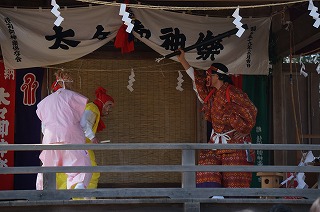
Look at that. Once again, a strange man with a red face has come. Who is he?
I’m not sure. Maybe he looks like an ogre. There are too many strange happenings.
This is because Daikoku left all his work to Modoki. He is responsible for all the happenings.
Oh, are you angry?

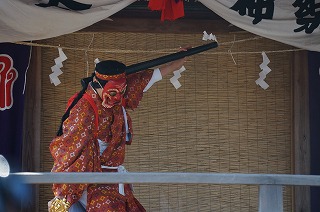

At last, Daikoku, Modoki, and the monkey-like creature drive away the ogre by throwing beans and all the cast have left.
What on earth has happened. Your guess was right.
Maybe they wanted to represent throwing away bad things and wishing for happiness. But I can’t explain this program in more detail.
”Zougi and Taihou” Two deities talk to each other, and wish for happiness.

”Kagutuchi“


Do you know who this deity is?
I don’t know.
He is a deity of fire. He can burn out everything.
Oh my God! That’s scary.

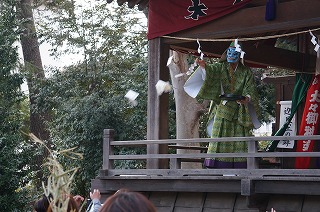
The last program. The blue face comes out holding a bell and a plate. He dances and throws many sweets or rice cakes and the program is over.
How about this kagura?
Although this kagura had some difficult parts to understand, I got many sweets. That’s right. All is well that ends well.
You are greedy till the end, deplorable!
to be continued to Part 3









